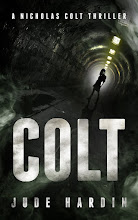The Scene Worksheet
SCENE: ACT: POV:
SETTING (period, duration, location, level of conflict):
EVENT:
GOAL (WHAT DOES THIS CHARACTER WANT?):
MOTIVATION (WHY DOES THE CHARACTER WANT THIS?):
CONFLICT:
VALUE SHIFT (+/- or -/+, i.e., WHAT CHANGES BY THE END OF THE SCENE):
IS THE GOAL MET? (YES, BUT...OR NO, AND FURTHERMORE...)
EMOTION:
WHAT DO WE LEARN ABOUT THE CHARACTER?:
This is a tool I came up with to help develop scenes. For those of you who outline, you can use it from the get-go. For those of you who don’t outline, like me, it can be used to make sure your scene has all the proper elements on rewrite.
Any suggestions for additions to my worksheet?
SETTING (period, duration, location, level of conflict):
EVENT:
GOAL (WHAT DOES THIS CHARACTER WANT?):
MOTIVATION (WHY DOES THE CHARACTER WANT THIS?):
CONFLICT:
VALUE SHIFT (+/- or -/+, i.e., WHAT CHANGES BY THE END OF THE SCENE):
IS THE GOAL MET? (YES, BUT...OR NO, AND FURTHERMORE...)
EMOTION:
WHAT DO WE LEARN ABOUT THE CHARACTER?:
This is a tool I came up with to help develop scenes. For those of you who outline, you can use it from the get-go. For those of you who don’t outline, like me, it can be used to make sure your scene has all the proper elements on rewrite.
Any suggestions for additions to my worksheet?


2 Comments:
Jude,
Titling my scenes and Chapters is a plus for me.
Chapter Title:
Scene Title:
Three other things that I've found helpful on my Scene Sheets are Dominant Action, Scene Purpose, and Scene Ending Hook.
Dominant Action in This Scene:
Dominant Conflict:
This Scene is provoked by:
This Scene’s purpose is to:
__ Move the master story line ahead
__ Introduce or develop characters
__ Introduce or worsen a problem
__ Solve a problem
__ Set up later scenes
__ Create atmosphere
(I figure if the scene doesn't serve one of these purposes, it ain't needed.)
Seque to Next Scene / Scene Ending Hook:
Also,
Key Information Conveyed in Scene:
Overall Pacing of Scene:
I'm enjoying your blog!
Kathy
Hi Kathy:
Thanks! Love your additions. On your "This scene's purpose is to:" list, you might check any or all of the boxes, but the one you absolutely must check, IMO, is "Move the master story line ahead." No matter what else a scene does, it must propel the plot forward. Mama don't allow no window dressing 'round here. :)
Post a Comment
Subscribe to Post Comments [Atom]
<< Home